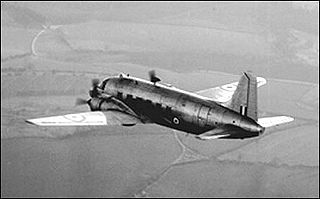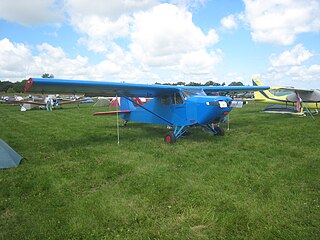Related Research Articles

The ERCO Ercoupe is an American low-wing monoplane aircraft that was first flown in 1937. It was originally manufactured by the Engineering and Research Corporation (ERCO) shortly before World War II; several other manufacturers continued its production after the war. The final model, the Mooney M-10, first flew in 1968 and the last model year was 1970. It was designed to be the safest fixed-wing aircraft that aerospace engineering could provide at the time, and the type continues to enjoy a faithful following.
The Lockheed Model 10 Electra is an American twin-engined, all-metal monoplane airliner developed by the Lockheed Aircraft Corporation, which was produced primarily in the 1930s to compete with the Boeing 247 and Douglas DC-2. The type gained considerable fame as one was flown by Amelia Earhart and Fred Noonan on their ill-fated around-the-world expedition in 1937.

The Cessna 120,140, and 140A, are single-engine, two-seat, conventional landing gear (tailwheel), light general aviation aircraft that were first produced in 1946, immediately following the end of World War II. Production ended in 1951, and was succeeded in 1959 by the Cessna 150, a similar two-seat trainer which introduced tricycle gear. Combined production of the 120, 140, and 140A was 7,664 units in five years.

The Ace Baby Ace, a single-seat, single-engine, parasol wing, fixed-gear light airplane, was marketed as a homebuilt aircraft when its plans were first offered for sale in 1929 — one of the first homebuilt aircraft plans available in the United States. Plans are still available and Baby Aces are still being built. Orland Corben designed a series of aircraft for the Ace Aircraft Manufacturing Company, the Baby Ace, Junior Ace, and Super Ace. Corben's name was associated with the aircraft, and it is commonly known as the Corben Baby Ace.

The Pitts Special is a series of light aerobatic biplanes designed by Curtis Pitts. It has accumulated many competition wins since its first flight in 1944. The Pitts biplanes dominated world aerobatic competition in the 1960s and 1970s and, even today, remain potent competition aircraft in the lower categories.

The Curtiss Robin, introduced in 1928, is an American high-wing monoplane built by the Curtiss-Robertson Airplane Manufacturing Company. The J-1 version was flown by Wrongway Corrigan who crossed the Atlantic after being refused permission to do so.

The Citabria is a light single-engine, two-seat, fixed conventional gear airplane which entered production in the United States in 1964. Designed for flight training, utility and personal use, it is capable of sustaining aerobatic stresses from +5g to -2g. Its name, "airbatic" backwards, reflects this.

The Luscombe 8 is a series of high-wing, side-by-side-seating monoplanes with conventional landing gear, designed in 1937 and built by Luscombe Aircraft.

The Piper PA-12 Super Cruiser is an American three-seat, high wing, single-engine conventional landing gear-equipped light aircraft that was produced by Piper Aircraft between 1946-48. The PA-12 was an upgraded and redesignated Piper J-5.

The Vickers Valetta is a twin-engine military transport aircraft developed and produced by the British manufacturing company Vickers-Armstrongs Ltd. Developed from the Vickers VC.1 Viking compact civil airliner, it was an all-metal mid-wing monoplane with a tailwheel undercarriage.
The AmEagle American Eaglet was a highly unorthodox ultralight sailplane marketed in the U.S. for homebuilding. It was a one-seat, high-wing braced monoplane that carried an inverted V-tail on a long boom extending from a pod-like fuselage. Intended for self-launching, it was equipped with a McCulloch go-kart engine and a folding propeller behind the cabin. Its first flight was on 19 November 1975, and by 1978, at least 250 sets of plans had been sold, with 12 aircraft reportedly completed.

The Curtiss Models F made up a family of early flying boats developed in the United States in the years leading up to World War I. Widely produced, Model Fs saw service with the United States Navy under the designations C-2 through C-5, later reclassified to AB-2 through AB-5. Several examples were exported to Russia, and the type was built under license in Italy.

The Fokker F-11 was a luxury flying boat produced as an 'air yacht' in the United States in the late 1920s. Technically the aircraft was the Fokker Aircraft Corporation of America's Model 9. It was sold in North America as the Fokker F-11 and was offered in Europe as the Fokker B.IV. By the time the first six aircraft had been constructed, it was already evident that the design was not going to sell well. A few were sold, two to notable multi-millionaires; Harold Vanderbilt and Garfield Wood each purchasing one. One was bought by Air Ferries in San Francisco. The F-11A cost $40,000 but the price was slashed to $32,500 as the depression set in during 1930. The F-11 was a commercial failure.
The Verilite Model 100 Sunbird was a low-cost light aircraft developed in the United States in the 1980s. It was developed by De Vore Aviation, a company that manufactures aircraft components, as a first foray into aircraft manufacturing. When initiated in 1983, the goal of the project was to create a two-seat light aircraft that could be sold for less than $US 20,000. Additionally, it was hoped that the Sunbird operating costs would be half that of a conventional two-seat aircraft. Funding for the project became available in 1985, and the Verilite subsidiary was created to develop the concept. The design was unconventional: a high-wing, strut-braced monoplane with the single engine fitted in pusher configuration at the rear of the wing, and the empennage carried on an aluminum boom. The pilot and a single passenger sat side by side in a fully enclosed cockpit, and fixed, tricycle undercarriage was fitted. Originally simply dubbed the "Affordable Airplane", the name "Sundancer" was chosen as the winner of a public competition, and later changed to "Sunbird".
The Apex Eco 6 is the first of a family of Czech single and two seat flying wing ultralight trikes that were designed and produced by To-Mi Aviation and later by Apex Aviation. The aircraft were supplied as kits for amateur construction.

The Wickham A Bluebird is an all-metal four passenger homebuilt aircraft designed by Boeing engineer Jim Wickham.

The Wickham B is an American experimental twin engined, homebuilt aircraft.
The Wickham Model E Sunbird II is a single seat homebuilt aircraft designed by engineer James M. Wickham. Jim Wickham had studied engineering at Ohio State University, and graduated from MIT as an Aeronautical Engineer. Wickham's career began at Chance-Vought, then in 1938 joined the Stearman division of Boeing. Starting in the 1950s, Wickham started designing and building his own series of homebuilt aircraft.
The Sunbird is a single-seater homebuilt motor glider, designed and built in New Zealand by Charles Stanton. It first flew in 1995, and was retired in 2005.
References
- ↑ Wanttaja, Ron. "Jim Wickham." Wind in the Wires, The Newsletter of EAA Chapter 26, Volume XIV No. 11 (Nov. 2006): pgs 3-4.
- ↑ "Wickham Model C" Federal Aviation Administration. Aircraft Registration Database .
- ↑ Wickham, James M. "A Spin Test." Sport Aviation, Mar. 1982: pgs 40-43.